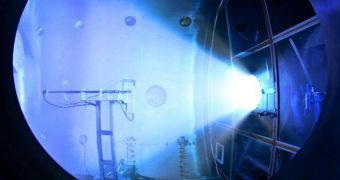Officials at the Ad Astra Rocket Company report high levels of power efficiency for their prototype rocket, which was tested at the corporation's labs in Houston, Texas. Upon completion, one such engine will be installed on the International Space Station (ISS).
Engines of this class are based on a new design called Variable Specific Impulse Magnetoplasma Rocket (VASIMR), which is powered by an advanced electro-magnetic thruster.
Propulsion is obtained by ionizing and heating propellant via the use of radio waves. After this step, the resulting plasma is accelerated using strong magnetic field, and released to produce thrust.
In essence, VASIMR is one of the few proposed concepts for electric space propulsion systems. Developing this design would have been impossible without conducting research into nuclear fusion.
The method of heating plasma that the engine uses was developed to do bring plasma in nuclear fusion test chambers to levels that would have ensured the onset of nuclear fusion between the hydrogen isotopes deuterium and tritium.
According to Ad Astra, the VASIMR propulsion system will ensure that the gap between high-thrust, low-specific impulse motors and low-thrust, high-specific impulse engines is covered.
Under a contract the company signed with the American space agency on December 10, 2008, the VASIMR VX-200 thruster, the first ever to be completed, will fly on the ISS in 2011 or 2012.
Ad Astra set its own efficiency milestones and standards, which are decided upon in agreement with the conditions stated in the NASA contract. Last week's tests, which ended on November 19, abide by all required conditions, officials at the company say.
Telemetry obtained during the test fires revealed that the NASA-set specifications have already been exceeded, and that a new efficiency record had been set at the company. The efficiency envelope of the VX-200 appear to be following a constant upward trend.
“The team’s accomplishment was impressive, as several control parameters intended for the final design are not yet available in VX-200,” says the Ad Astra head of technology, Dr. Mark Carter.
“Nonetheless, through clever operational modifications, based on subtle observations, the team accomplished the result. It required great attention to detail, rigorous scientific technique, and more than anything else, perseverance,” he adds.
“We can now exploit this new knowledge in the final design. It was great work by the team!” adds the official, who was also the principal designer of the second stage RF coupler, a key component in the engine.
“Many of the flight applications at the heart of our business model [such as cargo flights to the Moon and Mars] have required that the propulsion system achieve 60% system efficiency at 50 km/s exhaust velocity, says official Tim Glover.
“Now we have demonstrated in the lab the 70% thruster efficiency we need to achieve the 60% end-to-end system efficiency, at the required exhaust speed,” he goes on to say, quoted by Space Fellowship.
“Our technology is more mature and our company’s plans are on a firmer foundation,” concludes Glover, who is the senior Vice President for Development at Ad Astra.

 14 DAY TRIAL //
14 DAY TRIAL //